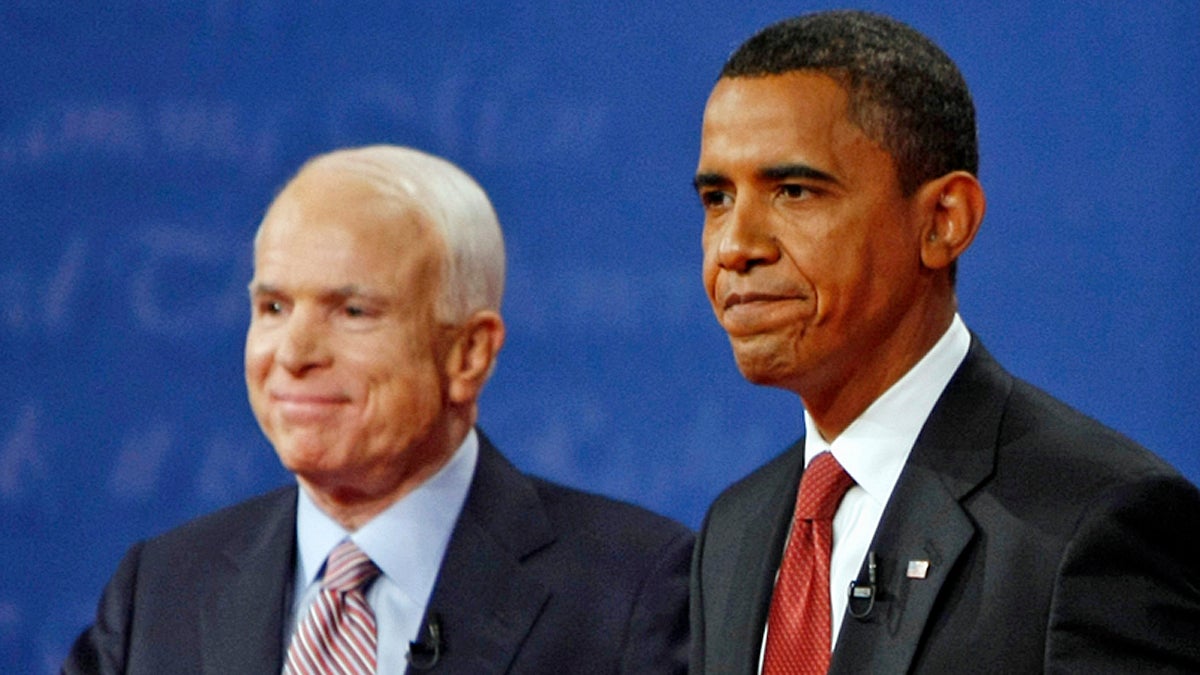From the State house to the White House
Listen
Republican presidential candidate, Sen. John McCain, R-Ariz., and then-presidential candidate, Sen. Barack Obama, D-Ill., on stage at the conclusion of a presidential debate at the University of Mississippi in Oxford, Miss. Friday, Sept. 26, 2008. (Gerald Herbert/AP Photo)
In 1947, historian Wilfred E. Binkley reviewed the thirteen men who had occupied the White House since the end of the Civil War. On average, the seven presidents who had served as state governors—including both Roosevelts, Theodore and Franklin—were markedly better than the six who had not. Indeed, Binkley concluded, the governorship was “a training school for successful presidents.”
And last November, at the Republican Governors Association meetings, New Jersey Gov. Chris Christie said much the same thing. “We’re better at it,” Christie insisted. “The American people are done with the experiment of having somebody [as president] who’s never run anything before.”
That’s becoming conventional wisdom in the GOP, where the list of potential 2016 presidential candidates is crowded with governors. Alongside Christie, there’s John Kasich (Ohio), Scott Walker (Wisconsin), Bobby Jindal (Louisiana), Mike Pence (Indiana), and Rick Scott (Florida). And don’t forget Arkansas ex-governor Mike Huckabee and Florida’s former governor Jeb Bush, who recently established a political action committee to explore a presidential run.
But if you look across our history, it’s hardly clear that former governors are more effective presidents; they include not just the Roosevelts but Grover Cleveland, Calvin Coolidge, and Jimmy Carter. And ex-governors’ fate at the national polls has ebbed and flowed as well, reflecting changes in the way that Americans think about government itself.
Before the American Revolution, colonial governors had been appointed by the British Crown. Americans in the early republic continued to view them with suspicion: in seven of the original 13 states, governors were elected for just one-year terms.
So the governorship wasn’t a stepping-stone to the presidency. After George Washington, the next five presidents gained office after serving as vice-presidents or secretaries of state. “The Governor counts for absolutely nothing and is only paid 1,200 dollars!” an American politician told Alexis de Tocqueville in the 1830s, when the French nobleman came to America to study its nascent democracy.
That began to change in 1876, when both parties nominated a governor for president. Although New York Gov. Samuel Tilden won the popular vote, Ohio Gov. Rutherford B. Hayes received the majority in the electoral college and ascended to the White House. (Another former governor, George W. Bush, would win the same way in 2000.)
For 52 of the next 68 years, a former governor served as president. Progressive-era reforms like child-labor laws and workplace safety regulation made state legislatures into “laboratories of democracy,” as future Supreme Court justice Louis Brandeis called them. They also made state governors like Theodore Roosevelt and Woodrow Wilson into much more prominent figures, who moved easily onto the national stage.
But after World War Two, governors lost their presidential mojo. All of our chief executives between FDR and Carter were former members of Congress except Dwight D. Eisenhower, an ex-general. Amid Cold War concerns over national security, voters preferred candidates who already knew their way around Washington.
Writing in 1959, pollster Louis Harris wondered if an ex-governor could ever win the presidency again. “In a cosmic, atomic, mass-media age, governors have shrunk to . . . local figures,” Harris wrote.
But the Watergate scandal of the early 1970s soured Americans on national government. So did the rise of modern conservatism, which devolved many powers to the states and made “Washington D.C.” a term of derision and scorn. Starting with Carter in 1976, four of the next five presidents were former governors.
Then came a U.S. senator, Barack Obama, who defeated a fellow senator (John McCain) the first time around and an ex-governor (Mitt Romney) the next. His party is likely to select another ex-senator, Hillary Clinton, to run in 2016.
And the GOP will probably choose a former governor, touting the nominee’s leadership experience and anti-D.C. bona fides. Like it or not, though, the scope and power of the federal government has expanded radically during the Obama years. From health care and immigration to the National Security Agency itself, Washington has assumed new authority in the lives of Americans.
And the stronger the federal government becomes, the more likely we are to elect a member of it. If a governor from the hustings doesn’t emerge as the front-runner, Republicans might choose someone from inside the Beltway–say, Sen. Ted Cruz or Rand Paul. The long string of ex-governor presidents was broken by Obama. With more power centered in Washington, Congress–not the statehouse–might become the new training school for successful presidents.
WHYY is your source for fact-based, in-depth journalism and information. As a nonprofit organization, we rely on financial support from readers like you. Please give today.

